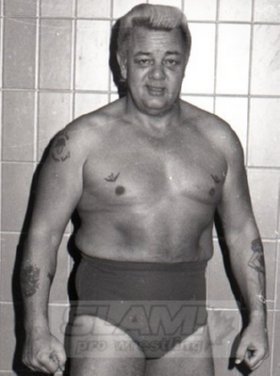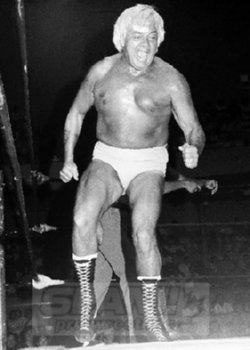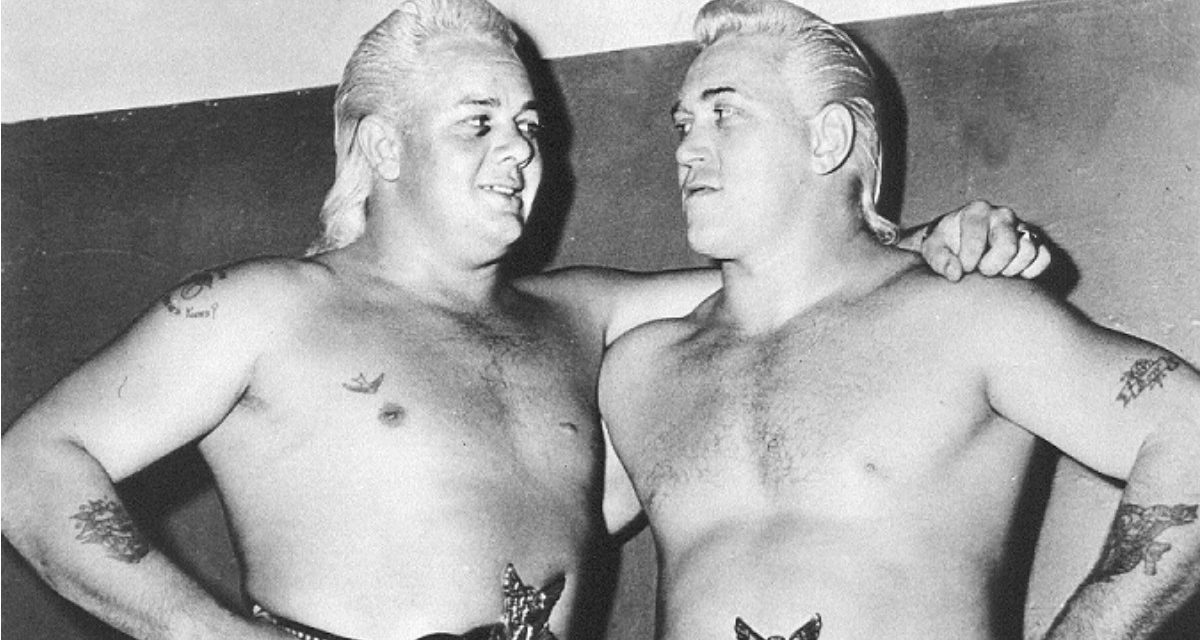There would come a time in the match where Jackie Fargo would make his comeback, but before going into it fully, would look out into the audience with a knowing grin, and then begin to strut. And not just any strut, but the Fargo strut, shaking his hips, bent over forward, hands extended, all done slowly, suggestively — and driving the crowd bananas.
With Fargo’s death on June 24, 2013 at the age of 82 — he would have been 83 on June 26 — there will be no more Fargo struts.

The one and only Jackie Fargo. Courtesy Chris Swisher
And don’t go saying that he stole the strut from “Nature Boy” Buddy Rogers.
“People say I did the strut because of Rogers, but I had never seen Rogers,” Jackie said in The Pro Wrestling Hall of Fame: The Tag Teams. “I just did it on my own and it got over like a zillion dollars. People wanted to kill me.”
Fargo had been in poor health for a couple of weeks, hospitalized with a serious heart problem, and had faced numerous other challenges over the years, including time in intensive care with pneumonia in both lungs back in December 2011.
A North Carolinian by birth, Jackie (real name Henry Faggart) was the original Fargo. Others would follow, creating a motley “family” that was as unconventional as it was entertaining.
Fargo started wrestling as a teenager at the YMCA in Goldsboro, N.C., and in the state championships, when a local promoter suggested he could make a few bucks by turning pro. He started wrestling around 1950 for Johnny Long, who was running opposition to Jim Crockett Promotions in the Carolinas. Riding a Greyhound bus ride all night from North Carolina to Atlanta, dressing in a cold bin, with no running water, and wrestling for $7.50 — from such meager stuff was the Fargo legend born. He headed to Cuba, of all places, making a lofty $250 a week in 1952 before Uncle Sam tapped him for service in the Korean War.
Part of the reason for his popularity was his unorthodox approach to showmanship as Honey Boy Fargo and Wildman Fargo.
“I had long blond hair and I wore a bone in my hair and would do anything goofy, pick up a big black lady, and sit in her lap and kiss her, stuff like that, just a wild man,” Jackie said in The Tag Teams. “I was young, just barely did start to shave.”
“Often imitated, never duplicated.” You hear the phrase all the time in wrestling, but if you want to know where it really originated, just hop on Interstate 85 north from Charlotte to the town of China Grove, the wellspring for the legendary Fabulous Fargos.
Jackie and Don Fargo (Don Kalt, a Pittsburgh bodybuilder) were the hottest tag team in the country in the late 1950s and early 1960s, selling out arenas from New York to Alabama, strutting to the ring with world titles wrapped around their waste, and setting the standard for every bleached blond tag team that would follow. When Don went his own way, Sonny stepped in as Jackie’s brother “Roughhouse” to equal success.
Cowboy Bob Kelly, who later had a violent singles feud with Don, called them “the best in the world. They were just ahead of their time. They were the first. They were just way ahead of everybody else.”
The Fargos drew the first 20,000-plus crowd in the history of New York City’s Madison Square Garden.
“We both had blond hair, long blond hair before anybody had it. Back in the ’50s, everybody had a crewcut,” said Don. “We started dressing exactly alike; we wore everything alike, the underwear, the socks, our rings, our watches. We even had earrings back then which nobody did.”
Everywhere it was the same: titles, arrogance, fan invective, and good money. “We could wrestle the devil and we would have been the heels,” Jackie joked. When Don stepped aside, Sonny, whose given name was Jack Faggart Jr., entered the picture. The Jackie and Sonny show worked regularly in Madison Square Garden several times in 1960, in between stints in the Carolinas, where they challenged teams like the Scott Brothers. Typical of their mischief was a 1960 bout in Danville, Virginia, where Jackie was disqualified in one fall for jumping on Frankie Cain’s neck, but won the two-out-of-three falls match by tossing his unconscious brother on a supine Cain behind the referee’s back after a midring collision.
Don and Jackie wrestled on and off as a team until 1965, when Don turned into wrestling’s greatest quick-change artist. He was a shoot-em-up cowboy with the Daltons, a biker tough with the Chain Gang, a bleached blond with Greg Valentines as The Fargos redux, a mercenary with the Legionnaires, and even a Fonzie character, based on the Happy Days sitcom, at one point.
In the meantime, Jackie became one of the first true villains in the squared circle to switch to good guy status, en route to becoming the biggest name in the wild-and-wooly history of Tennessee grappling. It wasn’t anything he did, he said; the fans just took to his brawling ways and cocky persona.
“I was the person people loved to hate, but they loved me,” Jackie said. “As much as they hated me, they loved that Fargo strut. Boy, they’d boo the heel out of me, but they loved that.”

Jackie Fargo does the strut. Courtesy Chris Swisher
At dire moments, he called in “Roughhouse” from a mental facility in North Carolina to even the score with some opponents. “Most of the fans in our area really thought he was nuts,” said promoter Jerry Jarrett. “Whenever we needed a shot in the arm, Sonny would come in to help out. Sonny was a good and decent person.” The duo held the regional tag team title in Tennessee in 1964. Back home, Sonny became probably more well-known as a referee than wrestler, though he was working as a grappler on and off through 1972.
With Don, Sonny, and others, Jackie had a share of at least 55 singles or tag team titles during his career, and brought Jerry “The King” Lawler into wrestling.
When he was young, Lawler worked as a painter for Fargo’s Memphis sign company; after working as a radio DJ, Lawler got into pro wrestling with Fargo as his mentor. “Without the Fabulous Jackie Fargo, there would never have been a King Jerry Lawler. RIP Jackie,” Tweeted Lawler.
“I think Jackie probably knew the crowds about as well as anyone I’ve ever seen. Maybe Ric Flair did,” said legendary Memphis announcer Lance Russell. “But he was just that way. It was just an instinct that Fargo had.”
Jackie Fargo would show up on Memphis television when ratings needed a boost or a gimmick needed a push.
The Fabulous Ones, Stan Lane and Steve Keirn, were a tribute to Fargo, for example. Promoter Jerry Jarrett telephoned Fargo in North Carolina to seek his seal of approval for a tag team in his flashy likeness. “I thought it was a great idea. See, I was ‘The Fabulous One’ and these guys were going to be my protégés. They were going to do the kind of things I would do, with all the color and all,” Fargo said.
In the late 1960s, Fargo scaled way back on wrestling; he had too many other fingers in various pots. He and buddy Eddie Bond peddled Fargo Burgers at their Southern Frontier restaurant, and Jackie had a fling as a country-and-western singer. He re-entered wrestling full time at the request of Jerry Jarrett, who started booking Memphis in the early 1970s and remembered the electricity Jackie and Don Fargo created at the old Hippodrome Arena in Nashville.
“This experience impacted my life more than I could ever imagine. When I began booking Memphis, the first person I went to see was Jackie Fargo and I successfully talked him into coming back to help me promote,” said Jarrett. “Jackie was the key figure in building Memphis wrestling to legend status. I know that I could never had enjoyed the success in this business that I did without the help and friendship of Jackie Fargo. He was a great wrestling talent, a wise booker, and a great friend.”
Fargo’s outlaw image extended well beyond his 2006 conviction on misdemeanor charges of running a gambling operation. In November 1968, he was arrested in Memphis on charges of beating his first wife, Fiorina, in the face. He pleaded guilty and was fined $150. The following year, he was arrested for assault and battery after a beef with Eddie Bond, his business partner.
In 1973, he and wrestler Mario Galento ended up in court following a bizarre incident in-ring incident. At a TV taping in June, Galento was told to enter the ring to pick up a night stick, but Fargo raced in and legitimately hit him in the head with the stick, opening up a wound that required 17 stitches. Memphis wrestling historian believe the attack came in response to a radio interview in which Galento exposed business secrets to a mass audience.
Galento claimed Fargo woke him up with a phone call in the middle of the night, a claim backed by Galento’s wife, who was on an extension. “If Jackie was sober, he wouldn’t harm me,” Galento told a local court. “If he was drunk, I think he would shoot me.” A judge dismissed the case on the grounds that both wrestlers would stay away from each other.
One of Fargo’s last matches was in 2004. Sal Corrente was a referee on that show. “Being around Jackie Fargo the few times that I was reminded me of meeting Buddy Rogers; when these guys walked in to a room they took over the room,” he posted to Facebook, recalling the main event from Throwback Night III at Memphis’ Mid-South Coliseum where Corey Maclin, Stan Lane and Jackie Fargo beat the Rock-n-Roll Express and Jerry Lawler when Fargo pinned Ricky Morton. “They had a presence about them that is hard to describe.” He wrestled again in 2006, at the age of 76.
Bobby Fulton of the Fantastics tag team was a close friend of Fargo, and Fargo joked at the 2009 Hall of Heroes banquet in Charlotte, N.C., that he was going to make a comeback with Fulton as his manager. “He was Babe Ruth to the people in Tennessee, Alabama, and Kentucky. What Babe Ruth was to baseball and Johnny Unitas was to football, Jackie Fargo was to wrestling,” Fulton said.
The Linn-Honeycutt Funeral Home in China Grove is in charge of arrangements.
RELATED LINKS
Greg Oliver will be strutting around his home office today in honour of Jackie Fargo. Greg can be emailed at goliver845@gmail.com, and you can follow him on Twitter @gregmep.

